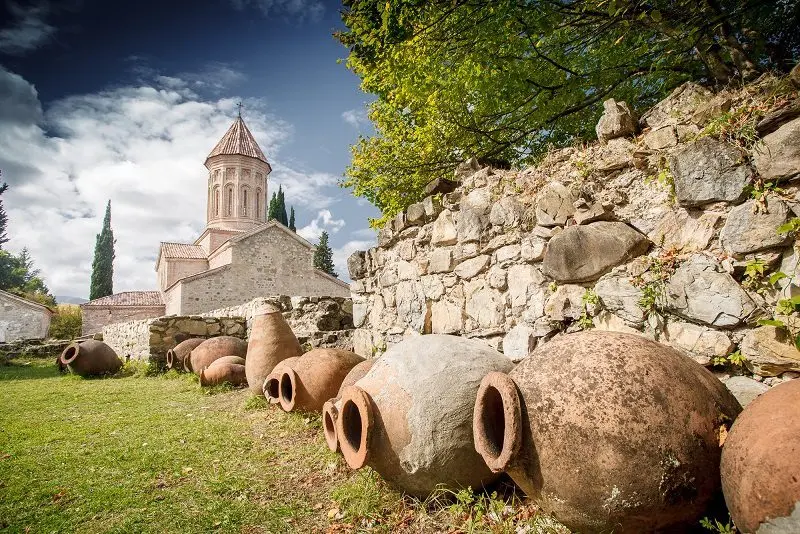Wine “Alazani Valley” is insidious – its quality strongly depends on the manufacturer. In the early 2000s, the market was flooded with second-rate and cheap Alazanka. Now the situation has changed, but for the generation of the 1980s, the name of the wine is compromised. After the 2006 embargo on Georgian wine supplies to Russia and the lifting of the ban in 2013, Georgian wineries are striving to follow European standards in order to compete. The wine has become better – but also more expensive, although it still belongs to the budget segment.
Features of the region
The Alazani Valley – also known as the “Kakhetian” – is one of the main and oldest wine-growing regions of Georgia. It has a mild climate, fertile soils, and the absence of droughts. Autochthonous grape varieties ripen well here, from which world-famous wines are then produced: Mukuzani, Rkatsiteli, etc. The valley got its name in honor of the Alzani River flowing here. This mountainous area with beautiful views remains one of the most popular tourist destinations in Georgia.

The brand of wine of the same name appeared in 1977, during the tenure of E.A. Shevardnadze and the active expansion of Georgian wines to the Soviet (mainly Russian) market. The name was chosen simply: the main raw material for this wine grows in the Alazani Valley, located between the Caucasian and Tsiv-Gomborg ridges.
Features
The semi-sweet Georgian wine “Alazani Valley” is made from the Rkatsiteli (white) and Saperavi (red) varieties, however, other grapes are allowed, for example, Aleksandrouli, Ojaleshi, etc. Despite the fact that this is a relatively young type, it is made according to the ancient the Kakhetian method.

Ripe berries are crushed in a special wooden vat (with feet or with a press) so that the juice, together with the pulp, flows into qvevri jugs dug into the ground. In these hermetically sealed vessels, the same temperature of 14-15 degrees is always maintained. Under such conditions, the future wine ferments for several months, then matures. However, producers who rely on quantity instead of quality can use modern technologies, keeping the drink in stainless steel vats and separating the juice from the pulp even at the fermentation stage.
Overwhelmingly, Alazanka is a good table wine with a balanced bouquet, but without the original taste. However, some tasters like the lack of acidity.

How to drink wine Alazani Valley
The white “Alazani Valley” is served at a temperature of 10-16 degrees. These drinks go well with vegetables, seafood, chicken, desserts. Red wines open better at 8-10 degrees, grilled dishes, meat, hot dishes are suitable as snacks. Both types are suitable for the role of both an aperitif and table wine.
Connoisseurs advise drinking Alazanka on its own, without eating anything – this light and pleasant wine with a strength of 11-13% quickly quenches thirst, and intoxication comes gently and gradually. The red “Alazani Valley” is a good base for spicy mulled wine.

Famous brands (manufacturers)
This wine is produced exclusively by Georgian wineries, in particular, Khareba, Shumi, Badagoni, Mikitani, Tamarani. Interestingly, the variety was immediately positioned as an export variety intended for sale on the Russian market. At home, the Alazani Valley is surprisingly rare.









